6 Proven Steps to Master Ecommerce Keyword Research

Written by Shreelekha Singh

Strategic ecommerce keyword research can help you reach the right audience and directly impact your bottom line.
Just look at Cosmetify’s success.
This beauty retailer was struggling with an all-too-common challenge: no traffic on its revenue-generating pages.
The team identified and mapped transactional keywords to these money pages.
Dorothy Edgar, SEO Manager at Cosmetify, shares more about her strategy:
“We also created new money pages to fit customer needs and gaps in our current website hierarchy. For example, we segmented the fragrance category page into ‘women’s perfume discounts.’ Then, we added optimized content to all these pages.”
The result?
A 12.6-position average keyword boost and a 250% jump in organic revenue in 2024.
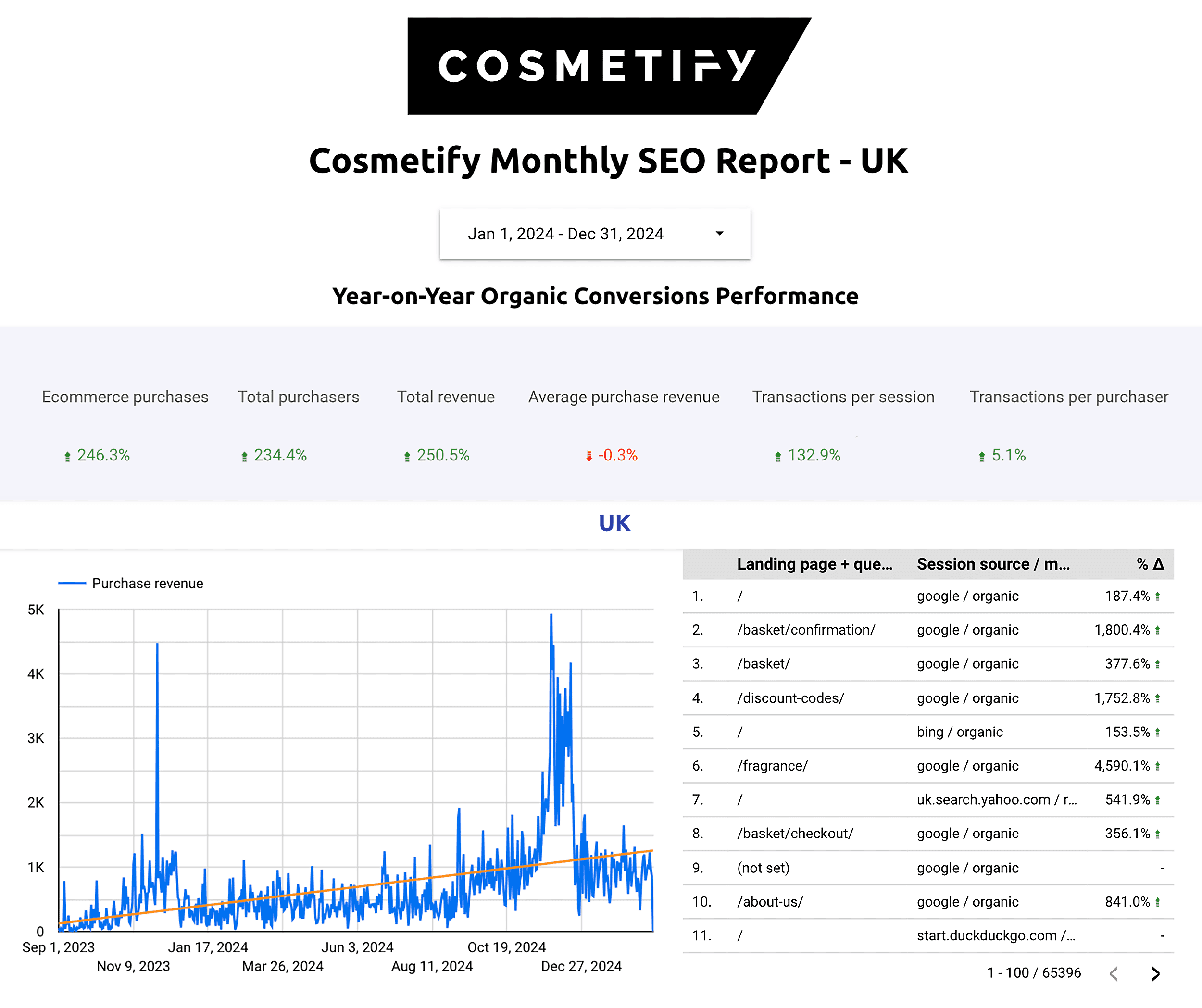
That’s just one example of the impact you can create with strategic keyword research.
Want these results for your business?
Use this 6-step framework to find revenue-driving keywords — without wasting time or budget.
Get started with our free Keyword Research Planner Template for ecommerce brands.
Why Ecommerce Brands Need Keyword Research
Keyword research reveals how your customers search, think, and make buying decisions online.
These rich audience insights can benefit your ecommerce business in many ways.
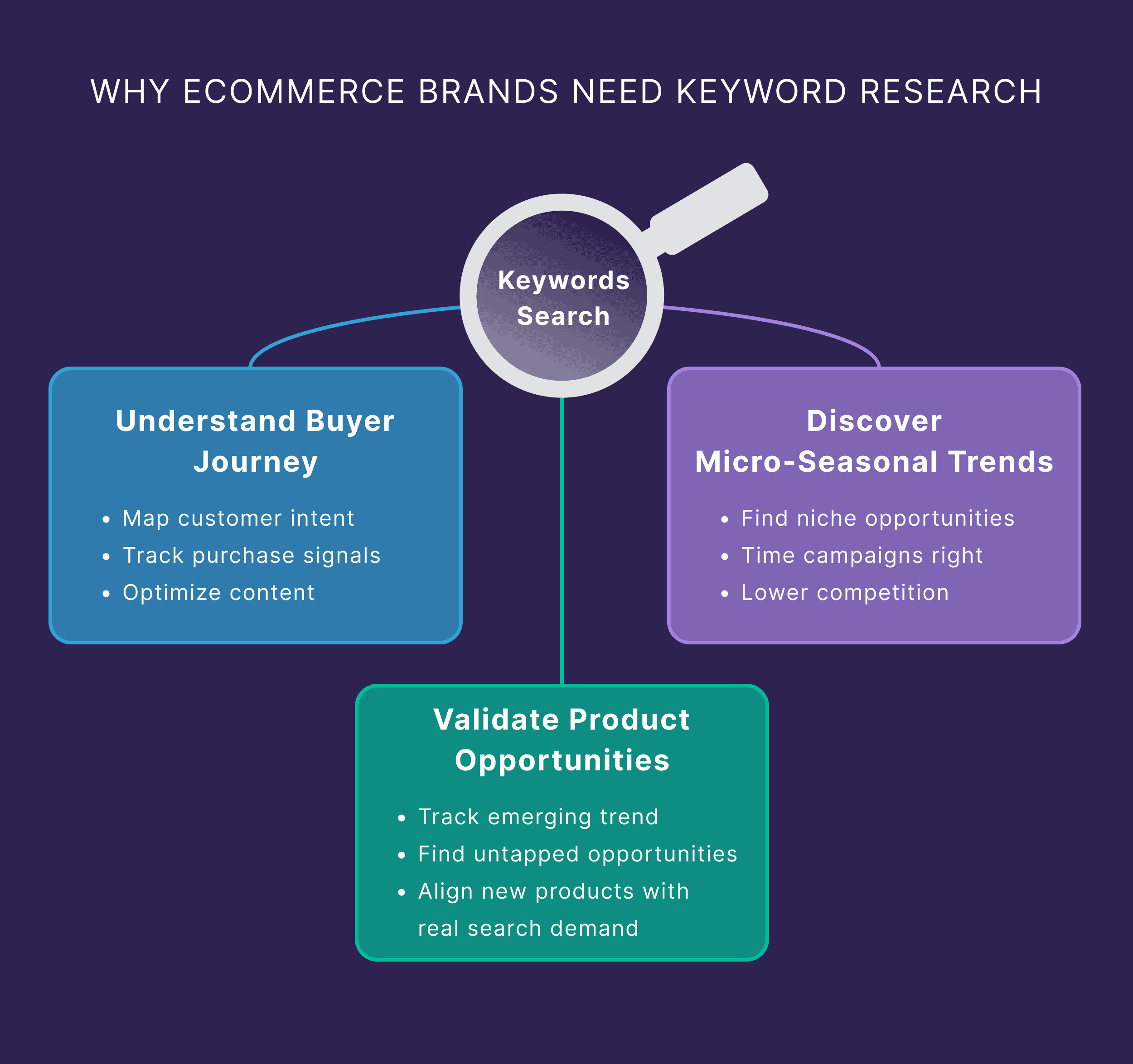
Understand the Buyer Journey
Keyword research helps you meet buyers where they are.
You get an insider’s view of your buyers’ psyche and willingness to purchase.
For instance, when people search for “benefits of running,” they want to learn more about this topic.
When they search for “best running shoes for flat feet,” they’re comparing different products.
In short: Choose keywords to target potential customers across the buyer journey and drive conversions.
Discover Micro-Seasonal Trends
The peak shopping season around holidays and festivals is ultra-competitive.
But ecommerce keyword research reveals micro-seasonal trends that your competitors might overlook. These less-competitive opportunities can drive more revenue with less effort.
Keep in mind that micro-seasonal trends differ across geographies and occasions.
For example, “back to school” is a trending topic in the United States from July to August.
If you run an online stationery store, target relevant keywords to tap into this demand.
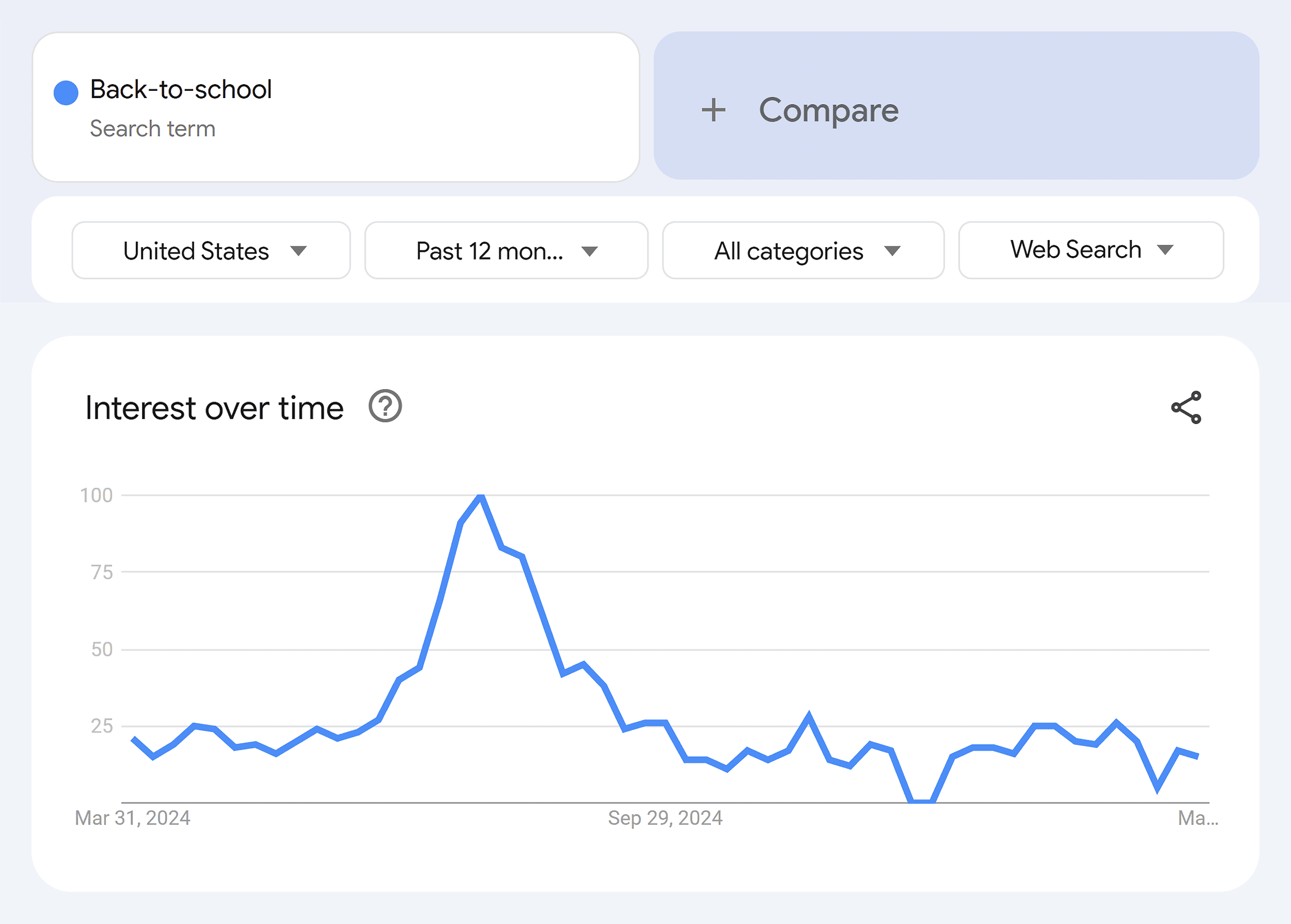
Validate Product Opportunities
You can also use this research to gauge your buyers’ interest in a new product idea.
A surging search volume for certain terms signals emerging consumer preferences.
For example, more people searching for “plastic-free activewear” could show growing interest in this product.
Analyze your keywords to find an untapped market for a new product category or niche.
Types of Keywords You Should Focus On for Ecommerce
Before I break down our 6-step framework for ecommerce keyword research, let’s cover the basics.
Ecommerce brands can target several types of keywords.
But, three stand out for driving customers through the buying funnel: informational, commercial, and transactional keywords.
Informational
Informational terms drive top-of-funnel traffic to your website.
These keywords make your brand more discoverable, especially when shoppers are looking to solve specific problems.
Target these search terms to provide helpful context about your products and put your brand on potential customers’ radar.
Informational keyword examples:
- How to choose running shoes
- Best skincare routine for oily skin
- Budget-friendly styling tips for small living room
Pro tip: Don’t just go after “best” and “how to” keywords. Use tools like AnswerThePublic or Semrush’s Keyword Magic Tool to find hidden gems in your niche.
Commercial
Commercial keywords bridge the gap between research and purchase.
Shoppers use these keywords to compare different products’ features that match their needs.
Commercial keyword examples:
- Best laptops for gamers
- Top-rated eco-friendly winter jackets
- Rothy’s vs. Allbirds everyday shoes
Transactional
Transactional keywords lead searchers to purchase and drive revenue.
These terms show a clear buying intent because shoppers use terms like “buy” and “book” or other strong purchase signals like pricing.
Transactional keyword examples:
- Running shoes under $100
- Buy a memory foam mattress
- Buy noise-canceling headphones
Here’s how these three keyword types map to the ecommerce funnel:
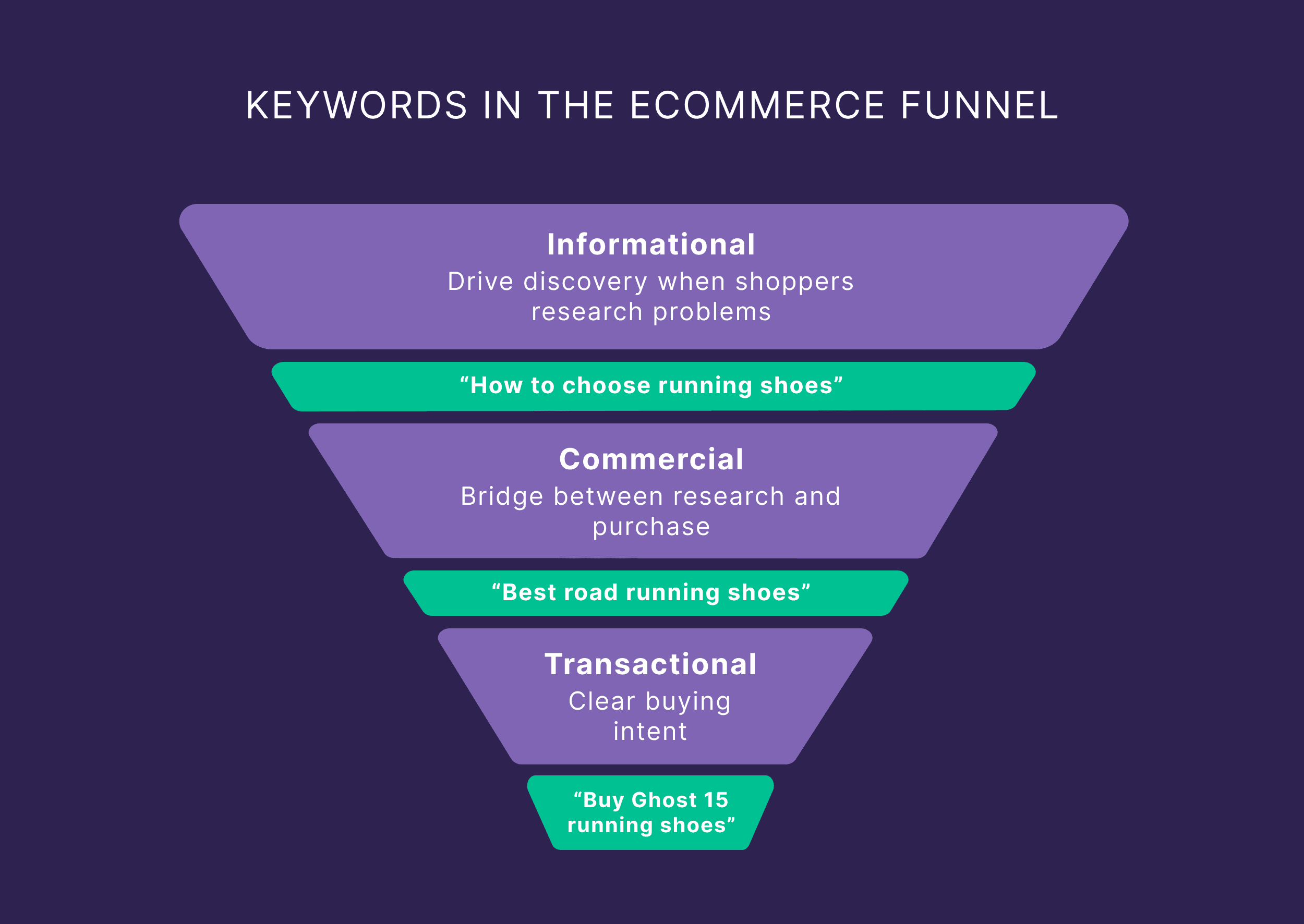
While these three keyword types map directly to the ecommerce funnel, they’re not the only ones worth targeting.
Navigational
Navigational keywords help searchers find a specific ecommerce brand, product, or page.
These queries also include category-specific navigation patterns people use to find specific products.
For example, “Under Armour men’s joggers” shows clear intent to find a specific brand and product.
Navigational keyword examples:
- Peloton treadmill
- Zara winter collection sale
- Lululemon Align leggings size chart
Long-Tail Keywords
Long-tail keywords are longer phrases searchers use for a highly specific need or niche topics.
Take the keyword “best running shoes for women with flat feet” as an example.
It’s longer than usual and searches for a hyperspecific product.
That level of detail can still bring in meaningful traffic — especially if it aligns with strong purchase intent.
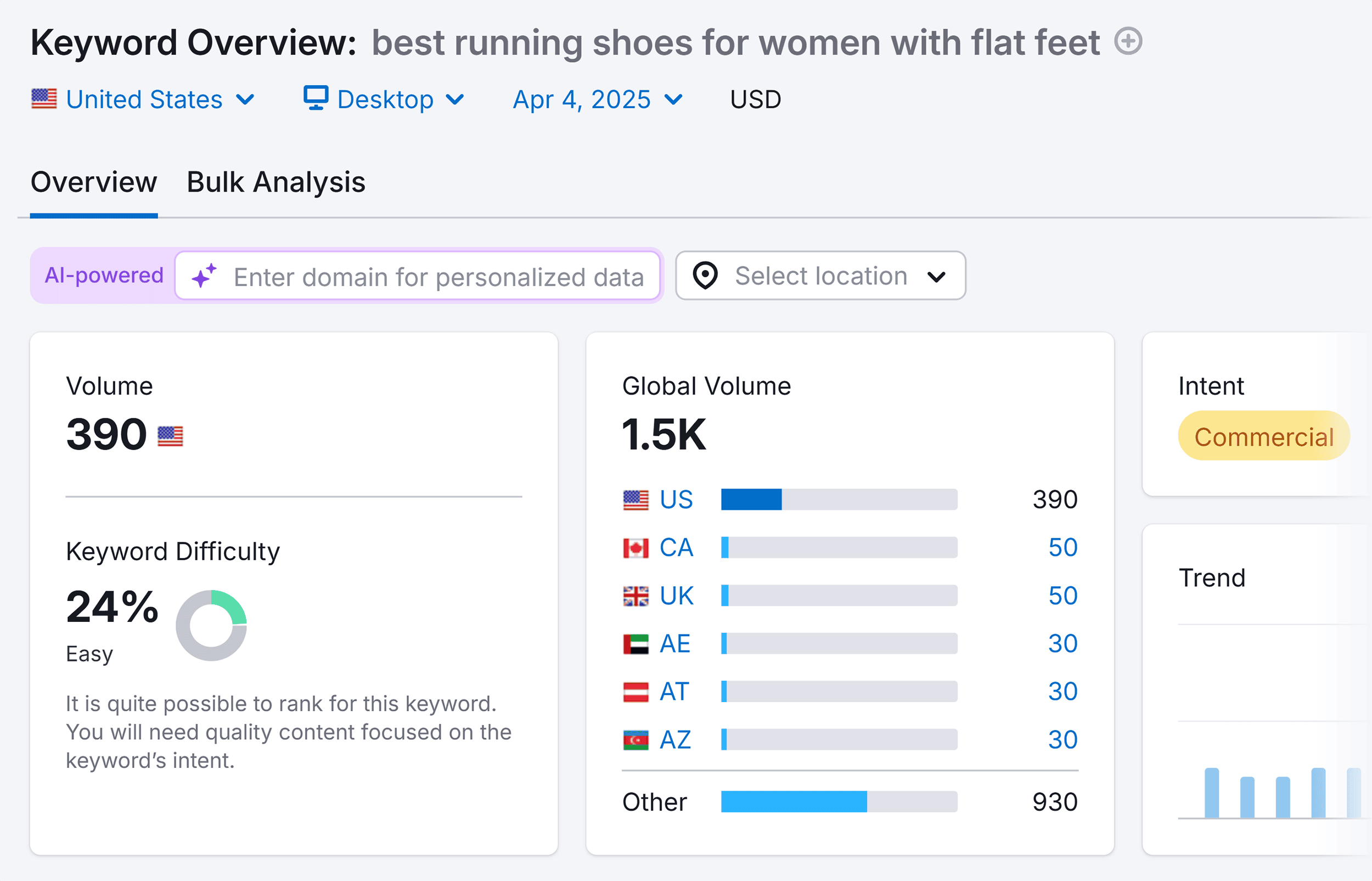
Long-tail keyword examples:
- Top-rated camping tents for families with kids
- Affordable stainless steel cookware sets for small kitchens
- Best organic baby food brands for sensitive stomachs
How to Conduct Effective Ecommerce Keyword Research
Buy a keyword tool → Find high-volume search queries → Add to landing pages.
That’s the outdated approach to finding keywords for ecommerce brands.
It’s a recipe for draining your time and money.
Let me break down a 6-step ecommerce keyword research process to drive sales and rewrite your growth trajectory.
Step 1: Identify Your Core Terms and Customer Language
Before you sign up for a keyword research tool, build some groundwork for your strategy.
Your first step? Listen to your customers.
The way people search for your products can be very different from how you describe them.
This misalignment could mean missed opportunities.
But when you speak your customers’ language, your content hits home.
Let’s look at the difference:
A skincare brand markets one of its products as a “10% niacinamide serum with zinc PCA.”
On the flip side, its target buyers search for “best serum for large pores” or “how to reduce facial oiliness.”
Same product. Completely different language.
Here are some more before (brands’ language) and after (customers’ language) examples:
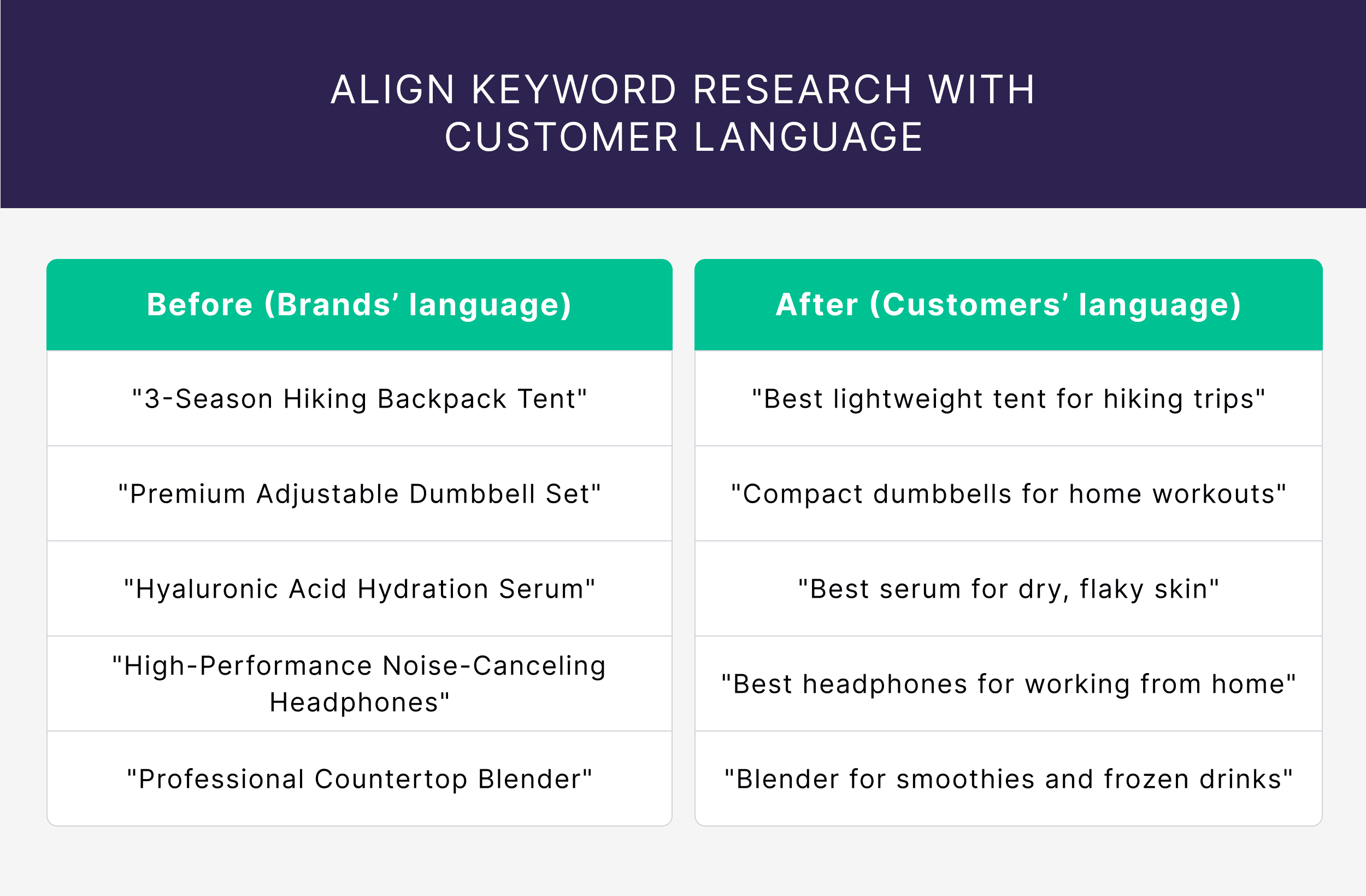
Here’s how to fix this language gap:
- Check product reviews: Notice how customers share their experience with your products. Find patterns in their language.
- Read support tickets: Note down questions or concerns customers frequently ask. Check your support center and email to find these questions.
- Monitor social media: Track comments on your social posts, especially questions. Learn how customers talk about your products.
- Analyze on-site search: See the terms a prospective buyer searches for on your ecommerce site. These direct queries show exactly what they’re looking for.
Let’s understand this with an example from Made In, a cookware brand.
Made In describes its Carbon Steel Wok with this product description. It talks about the wok’s weight, bottom, seasoning time, and more.
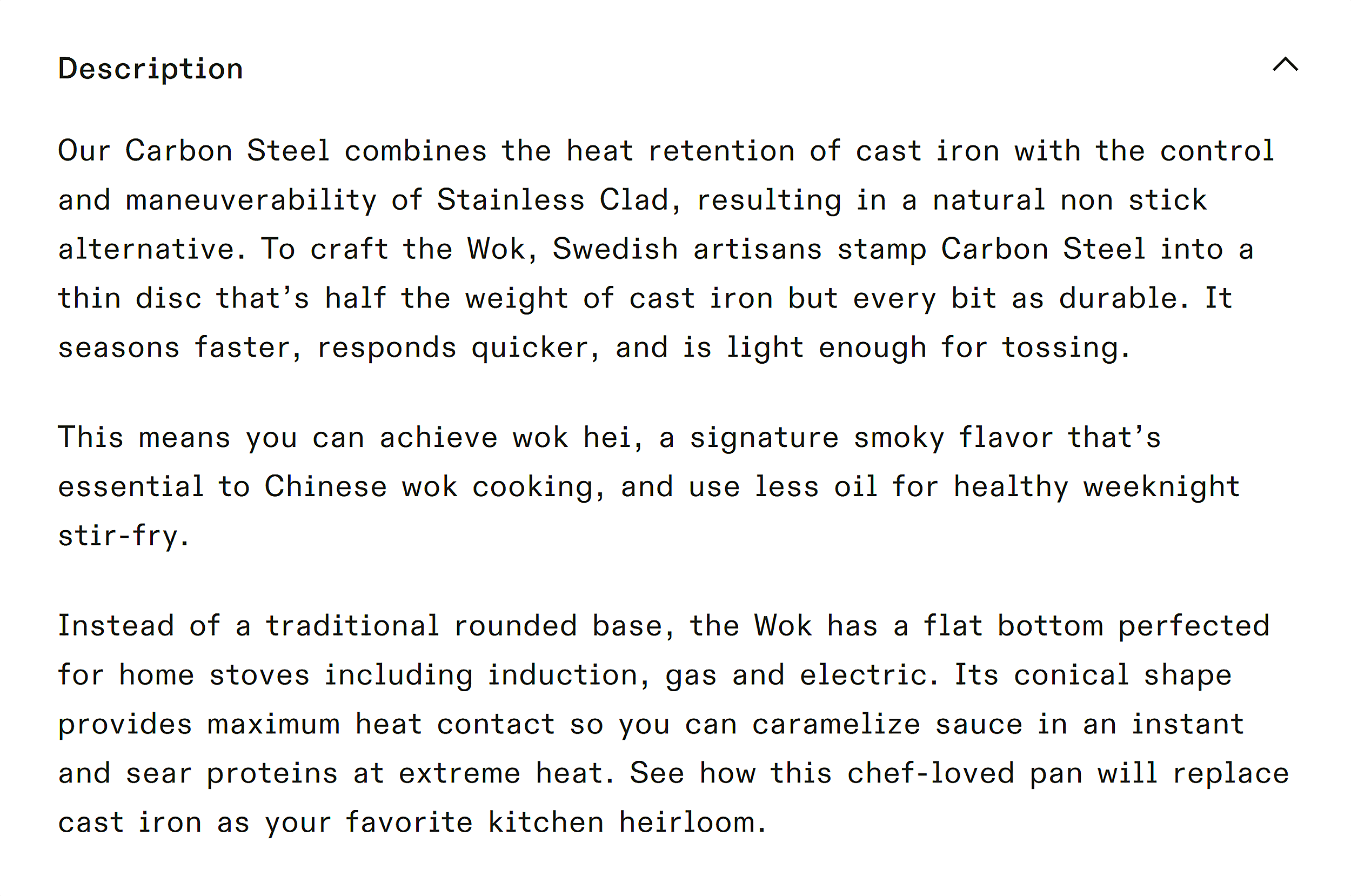
But customer reviews echo praise for one unique feature: the wok’s heat distribution.
Now, re-read the description.
You’ll realize it misses the one value proposition that most customers are raving about.
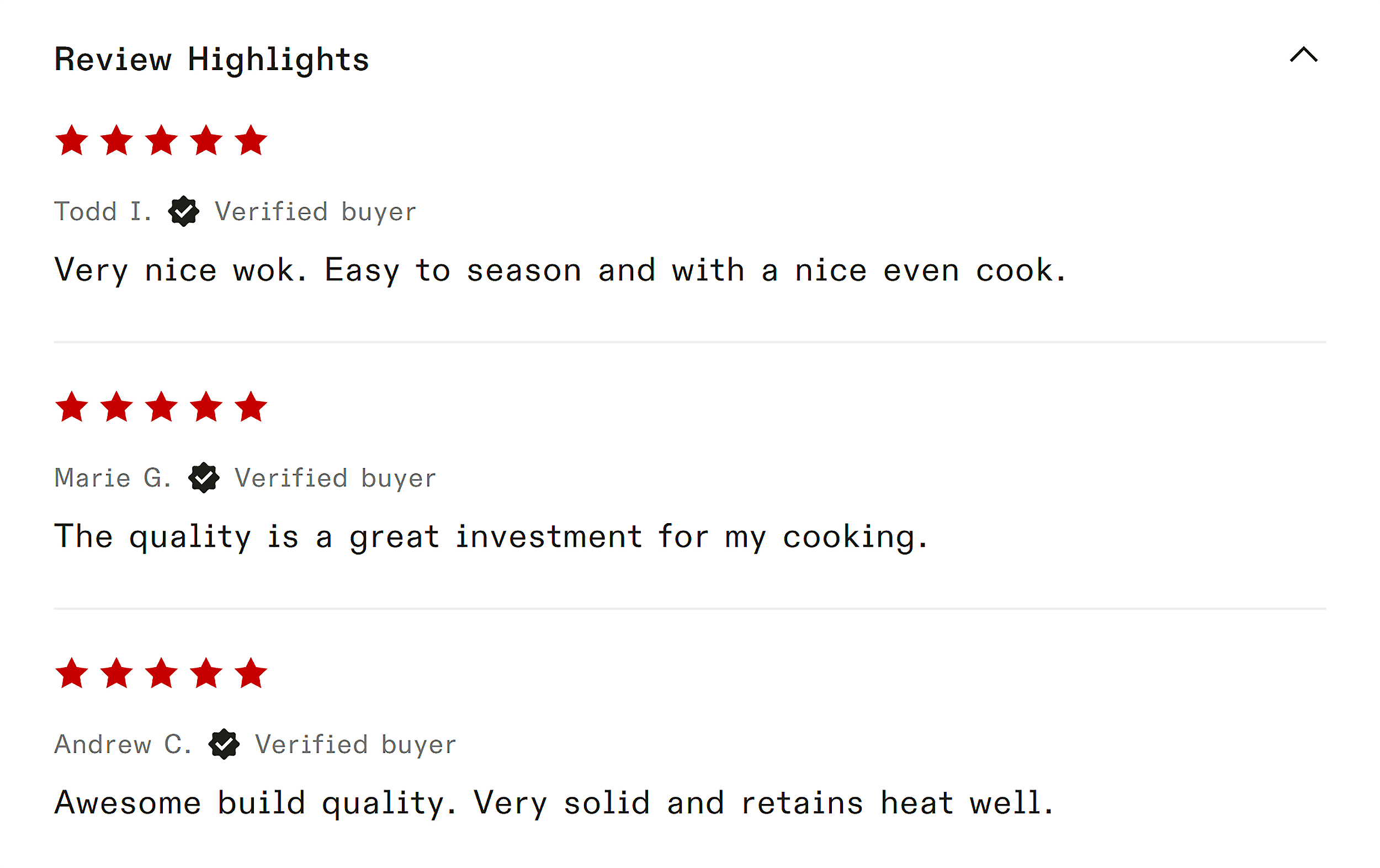
Step 2: Generate a Broad List of Seed Keywords
Once you’ve ticked off Step #1, it’s time to expand your keyword universe.
Most ecommerce sites limit themselves to product-related keywords — like a coffee maker brand targeting “single-serve coffee maker” or “burr grinder with timer.”
The result? Missing out on valuable traffic opportunities.
Customers search for your products in dozens of different ways based on:
- Their awareness level
- Their unique pain points
- Their budget preferences
- The features they care about
Go beyond your product-specific terms and find seed keywords that match your customers’ search habits.
One way to do this is by listing your products, alternative names, categories, and use cases.
For a product like “coffee maker,” you can start with seed terms like:
- Coffee maker
- Coffee brewer
- French press
Here’s a more detailed matrix for this brand:
| Core product | Alternative names | Product categories | Use cases |
|---|---|---|---|
| Coffee maker | Coffee machine | Drip coffee maker | Brewing coffee |
| Espresso machine | Coffee brewer | Single-serve coffee maker | Morning routine |
| French press | Coffee pot | Pour over coffee | Office coffee |
| Cold brew | Percolator | Coffee grinder | Entertaining guests |
| Moka pot | Coffee system | Coffee accessories | Specialty drinks |
When this exercise is complete, add all the keywords to your planner.
As we go through the next steps, gather more details about each keyword and add insights in different columns.
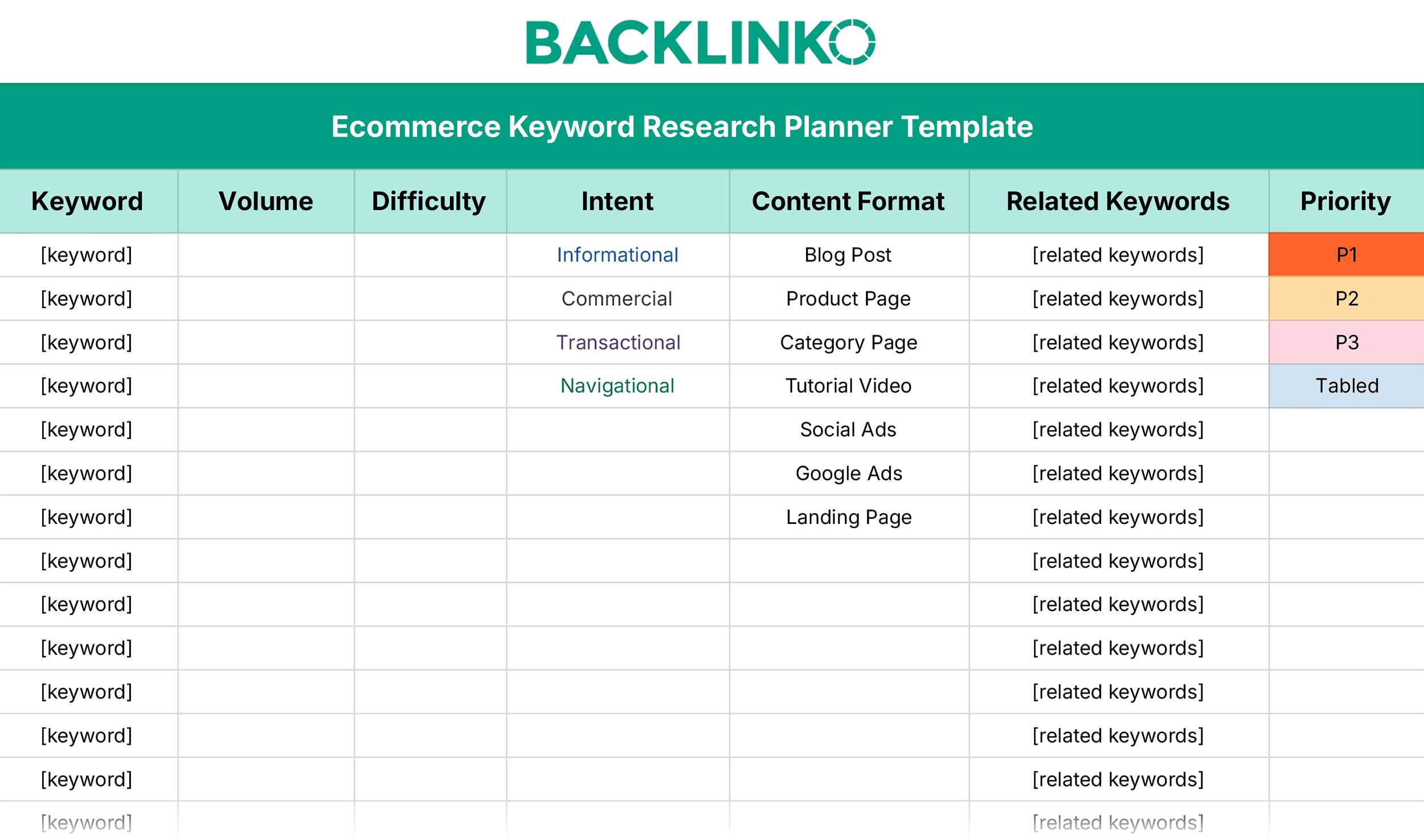
Step 3: Categorize Keywords by Buyer Journey
Not all keywords are created equal.
A person searching for “how to set up a camping tent” is in a completely different mindset than those searching for “buy a lightweight camping stove.”
The first searcher needs educational content. Show them a product page, and they’ll bounce.
The second one is ready to buy. Send them a how-to guide, and you’ll lose the sale.
Take a quick look at the search results and you’ll see this in action:
- For the “how to” query, Google serves up helpful blogs and videos.
- For those looking to buy, the search results are filled with different product options.
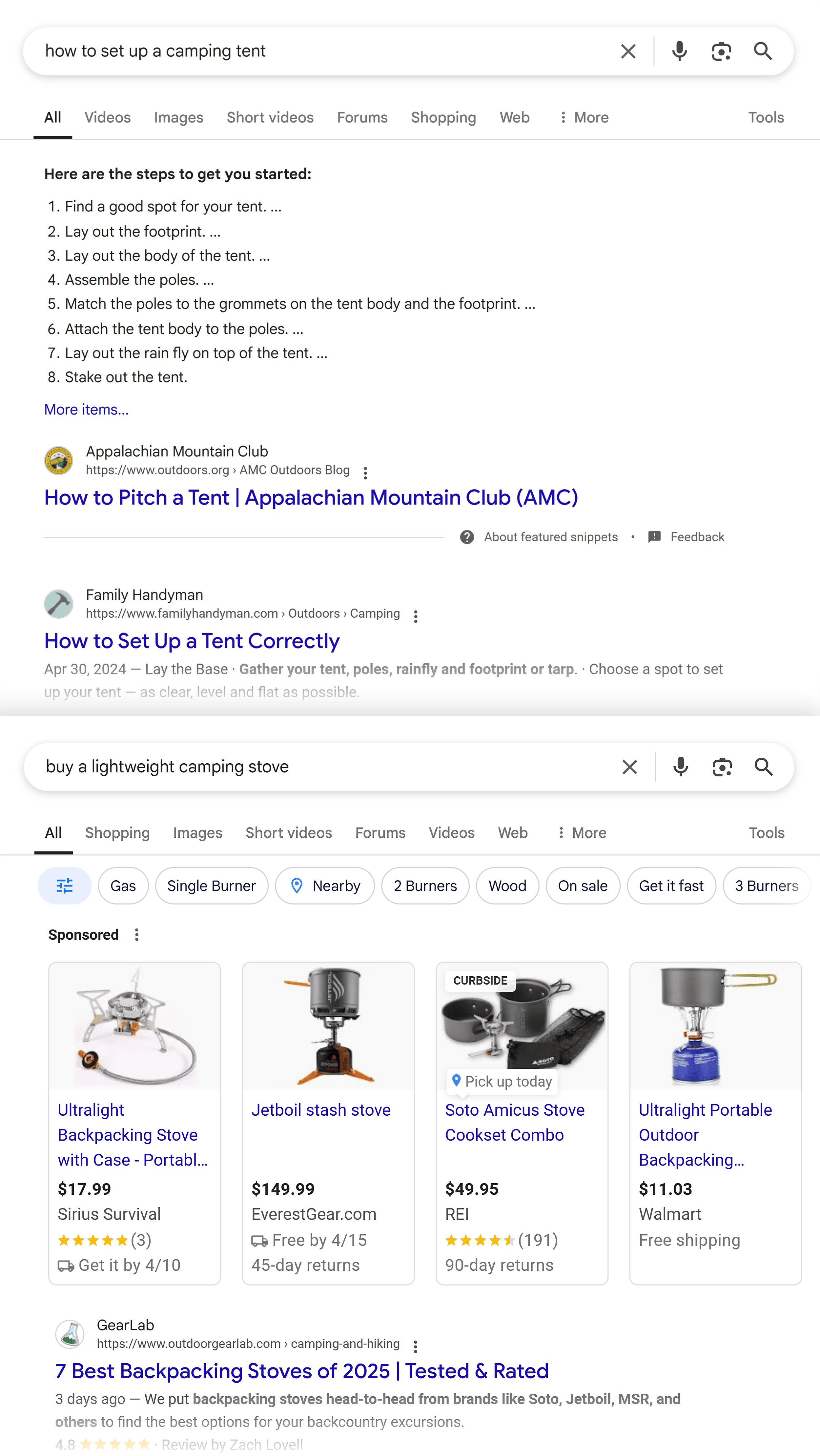
Knowing these differences allows you to target people across the entire buyer journey.
Follow this process to map keywords to varying search intents.
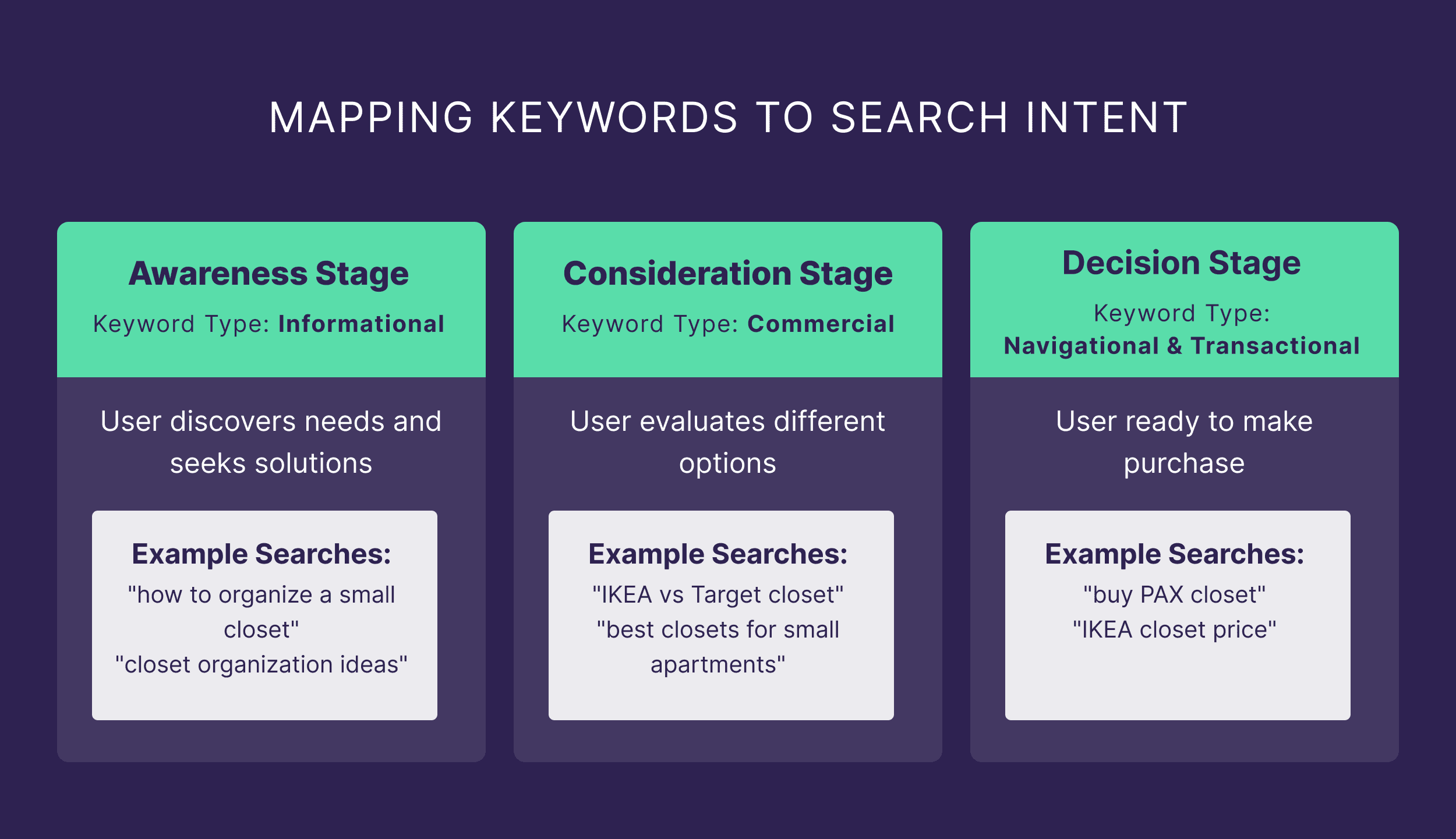
Awareness Stage
Keyword type: Informational
In the awareness stage, your buyers are simply discovering their needs.
They want to better understand their problems and find solutions. They’re not ready to buy yet.
Take Andy, for example.
He struggles with a small, messy closet.
So, he searches for “how to organize a small closet” and “closet organization ideas.”
Andy can discover your furniture brand if you have educational content on this topic.
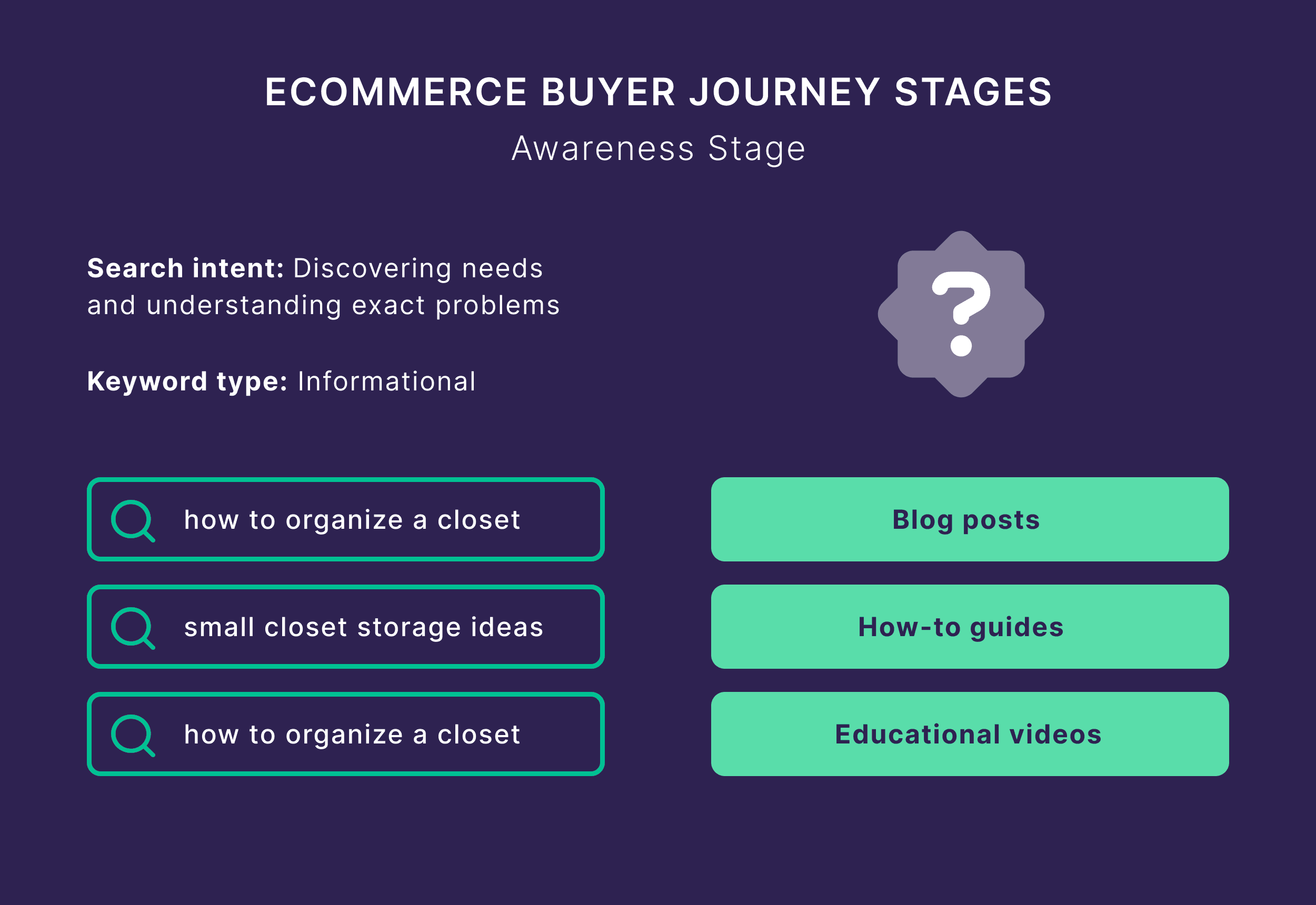
Consideration Stage
Keyword type: Commercial
In the consideration stage, people want to do their research before buying something.
They evaluate many products and weigh their options for making an informed decision.
At this point, Andy searches for “IKEA vs Target closet” and “best closets for small apartments.”
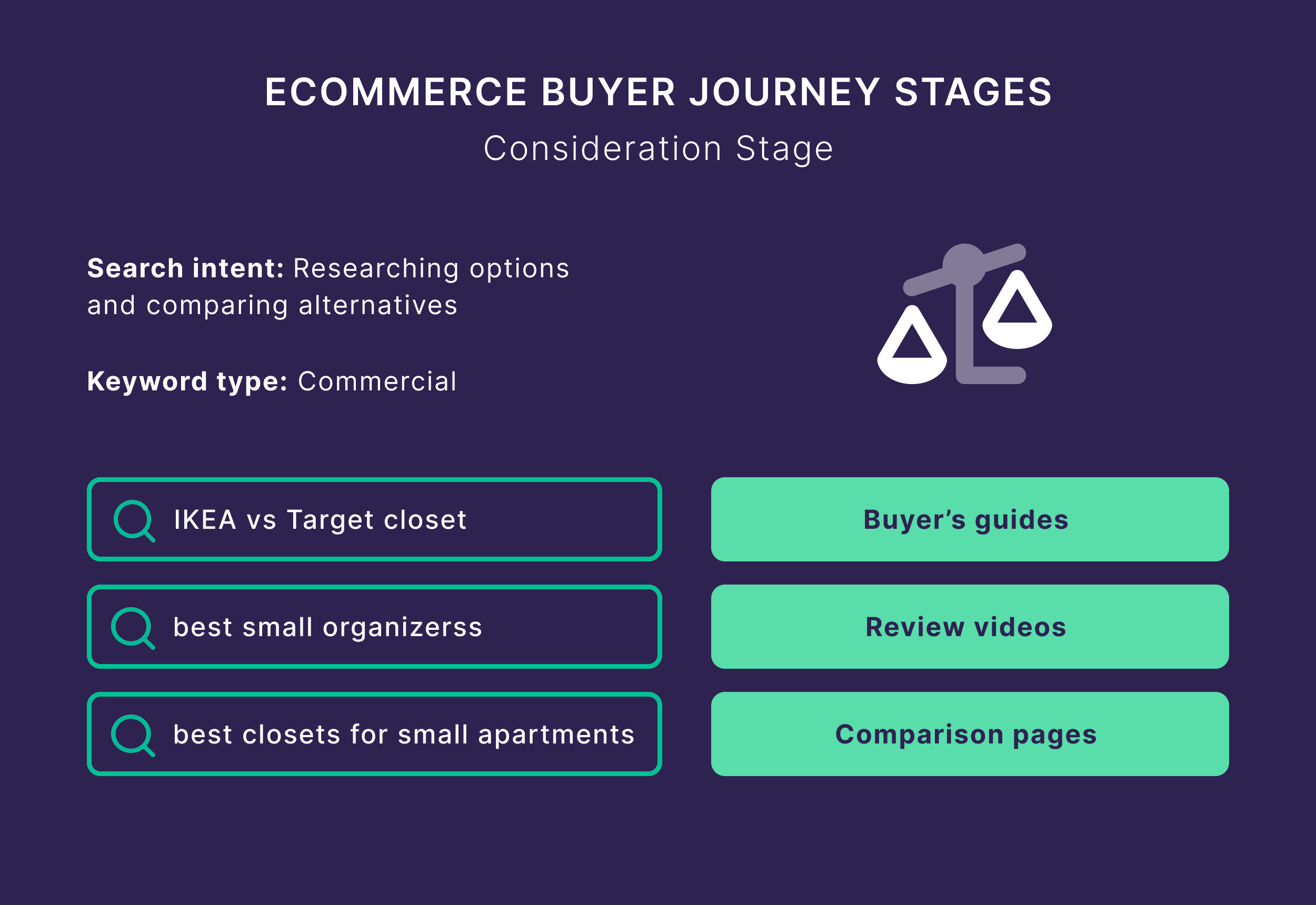
Decision Stage
Keyword type: Navigational and transactional
In the decision stage, your prospects are ready to buy.
They’ll search for high-intent keywords that shorten the path to purchase.
So, Andy will search for “buy PAX closet” to access the IKEA product page directly.
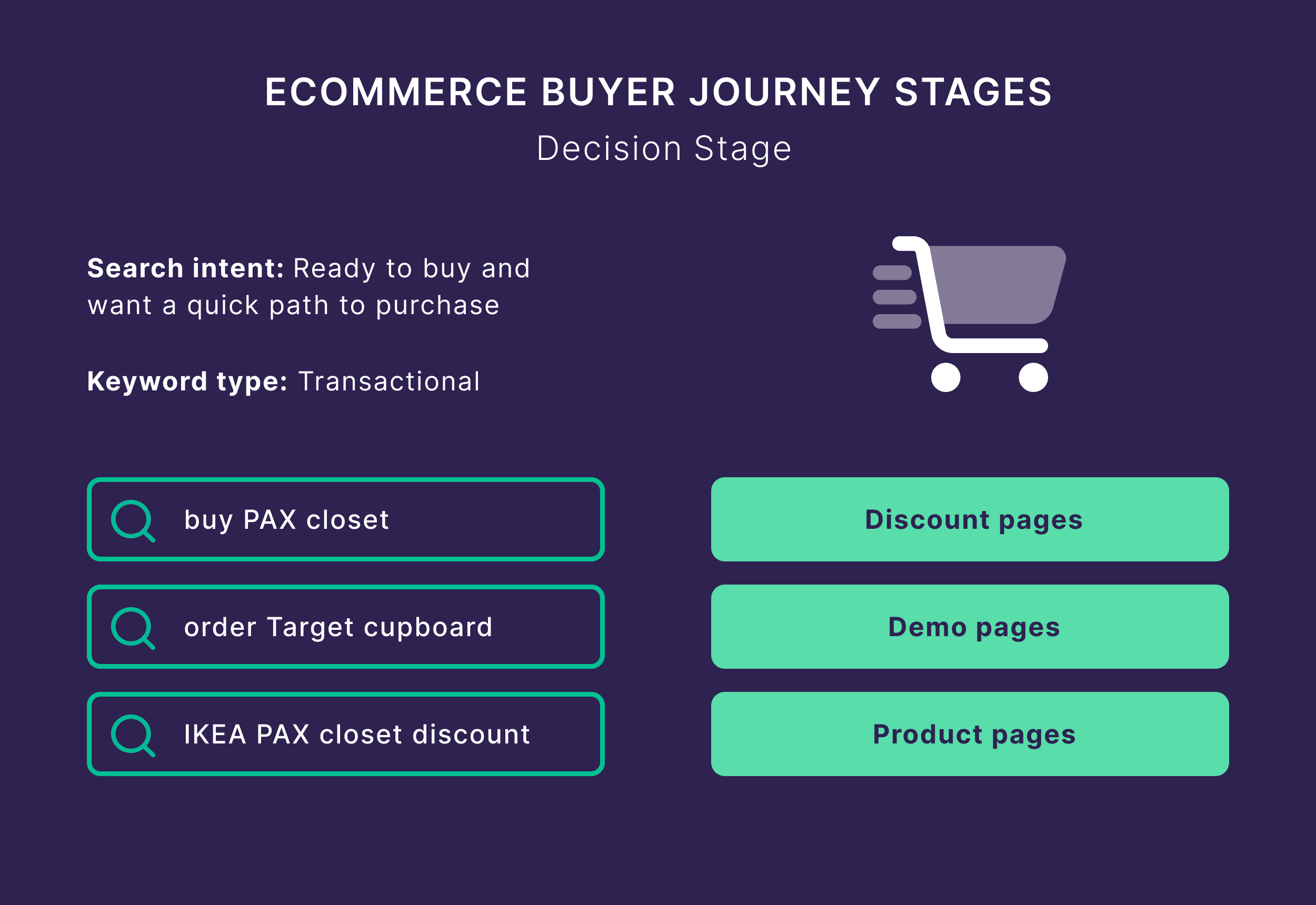
Map Your Keywords to Website Pages
Once you’ve identified a broad set of terms, map them to relevant pages on your site.
Use our planner template to define the content format for each keyword.
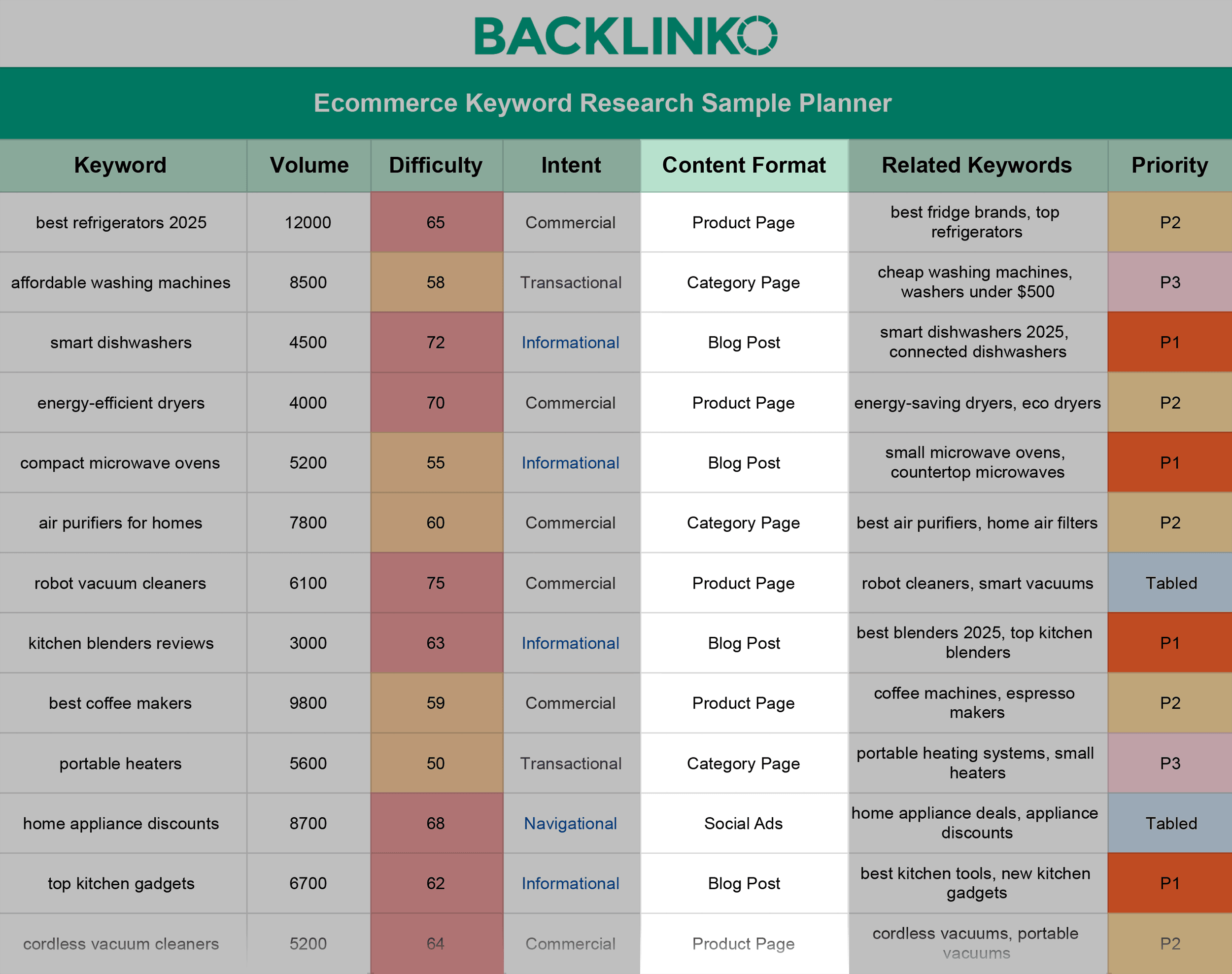
Keyword mapping gives each page a clear purpose and aligns keywords to these pages.
Nicola Hughes, Head of SEO at TAL Agency, shares how this benefits ecommerce brands.
Her team worked with a premium food and beverage brand to revamp its organic SEO performance and drive more sales.
“We listed all the collection and product pages on the site to define a purpose for every page. From there, we conducted in-depth keyword research to learn what our audience was searching for.
We mapped 1-3 high-intent keywords per page to align content with search queries across every stage of the funnel.”
This tactic, along with a few more, improved the brand’s click-through rate from 17.1% to 22.1%. It also led to 620% quarter-over-quarter growth.
Step 4: Research Your Competitors’ Keywords
Competitor keyword research tells you what’s working in the market — without blowing your budget on trial and error.
Look at direct and indirect competitors to find high-potential keyword opportunities.
An ecommerce keyword research tool like Semrush makes it easy to perform a keyword gap analysis.
Go to the Keyword Gap tool and add your competitors to discover the terms they’re ranking for.
I added three skincare brands and hit “Compare.”
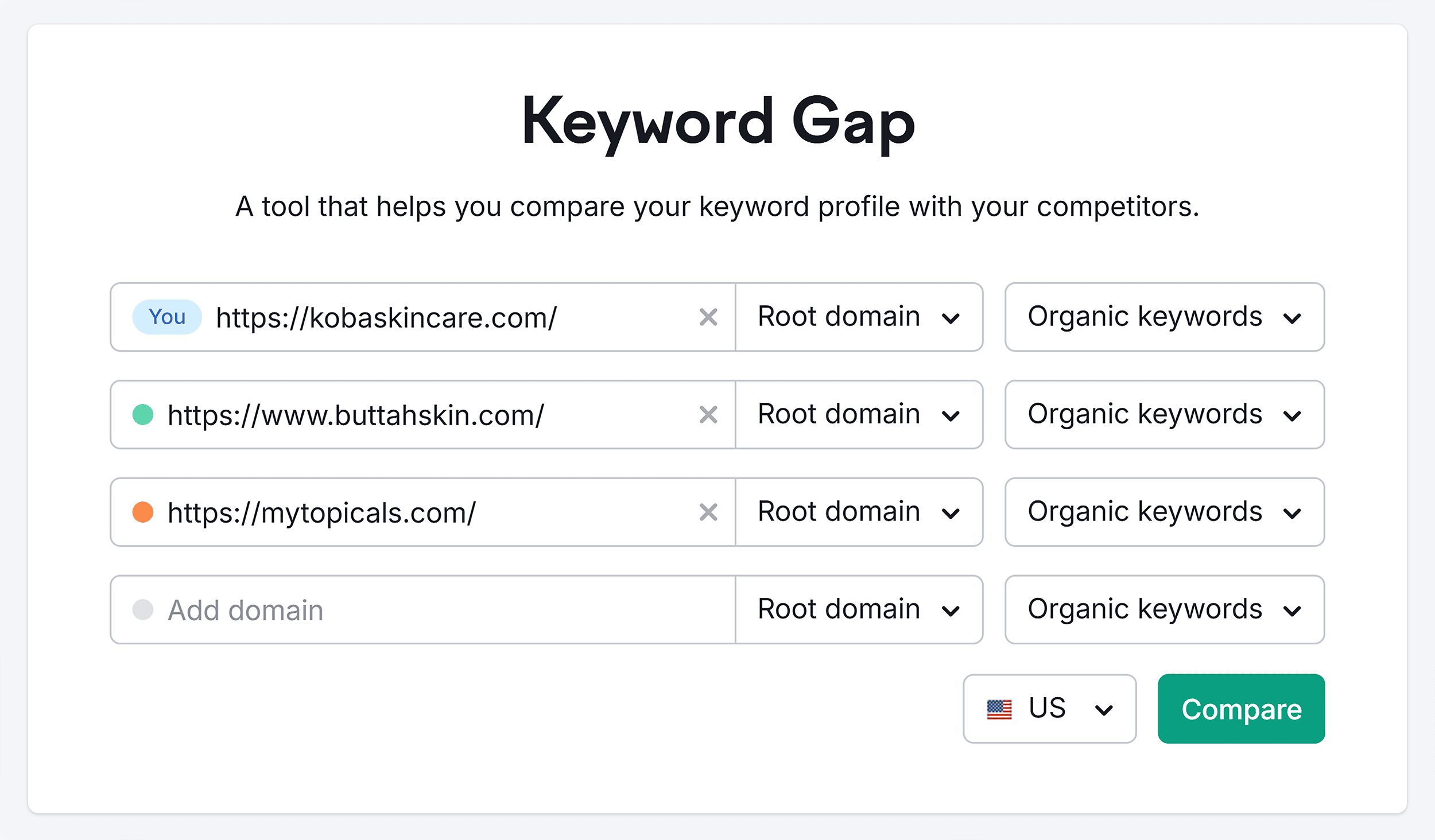
In the analysis, I could see how many search terms each brand targets.
This Venn diagram shows that Koba has the smallest share of keywords out of the three.
The tool also curates a set of missing and weak terms that Koba should target.
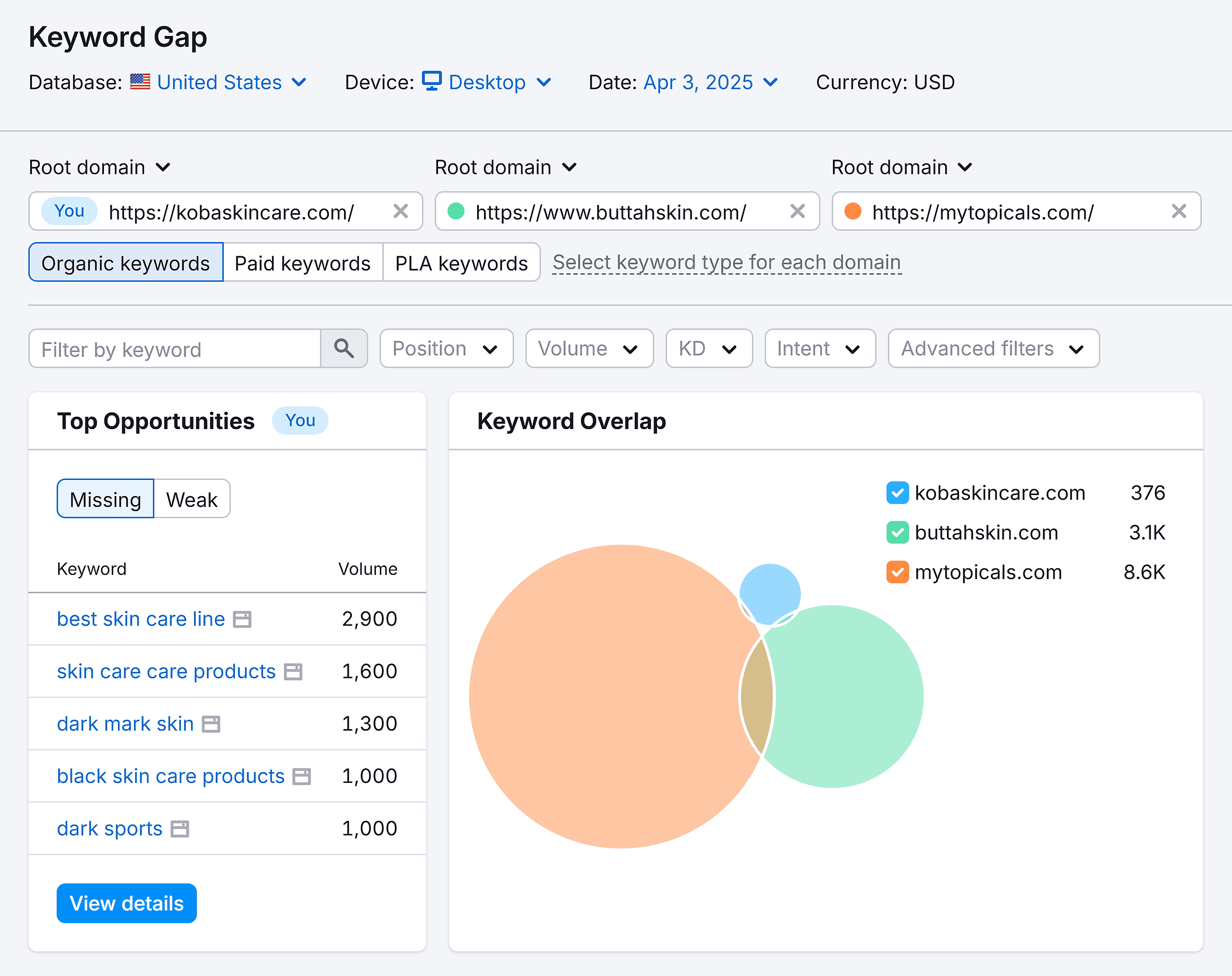
Keyword Gap analysis presents a list of 14.1K untapped keywords for Koba. Other competitors are already targeting and
ranking for these search terms.
I can select relevant phrases from this data and add them to a new list of competitor-specific terms.
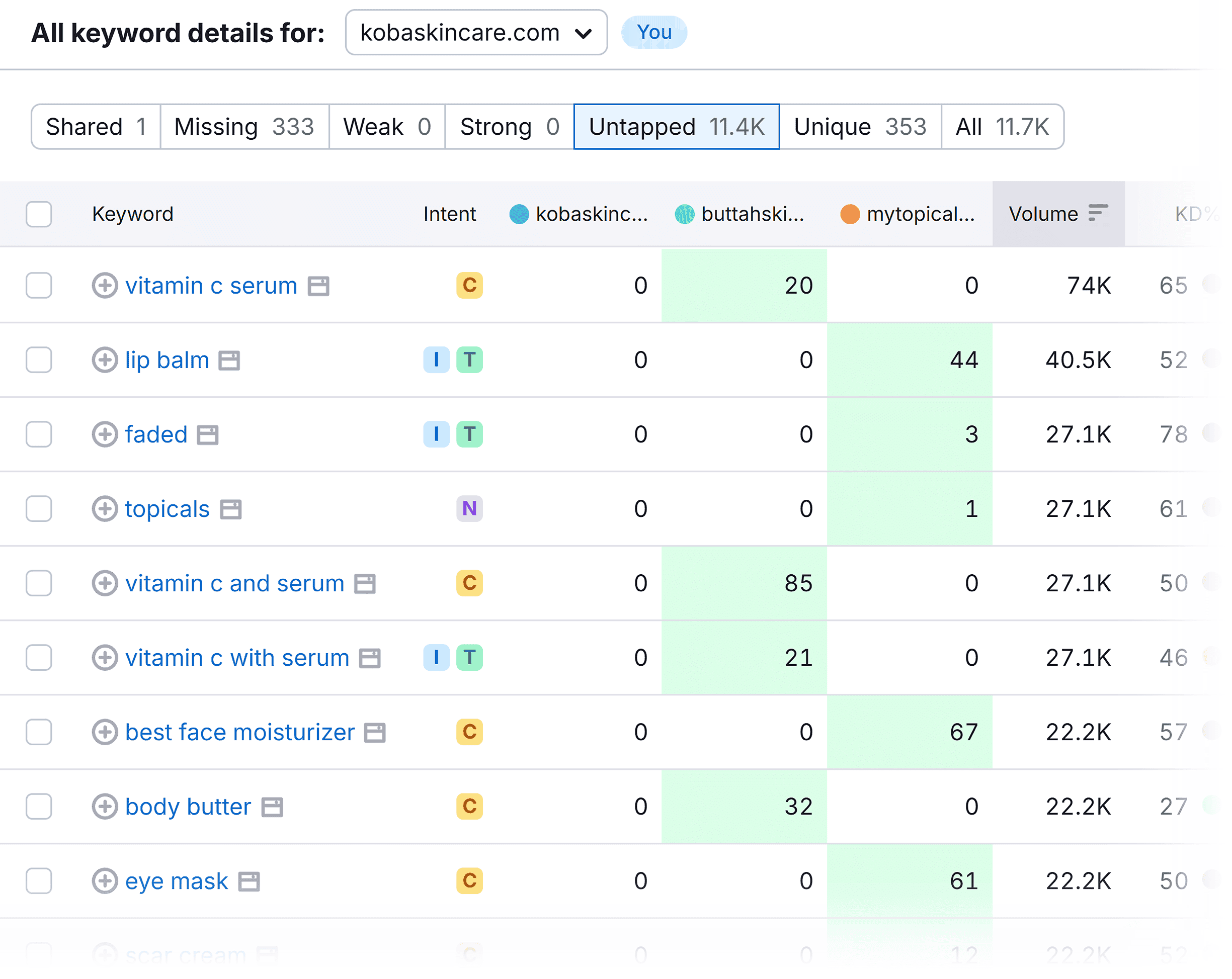
But only finding competitor keywords isn’t enough.
You have to analyze how competing brands target these terms.
Hover over any term in a competitor’s column. You’ll see the page where they use this specific phrase.
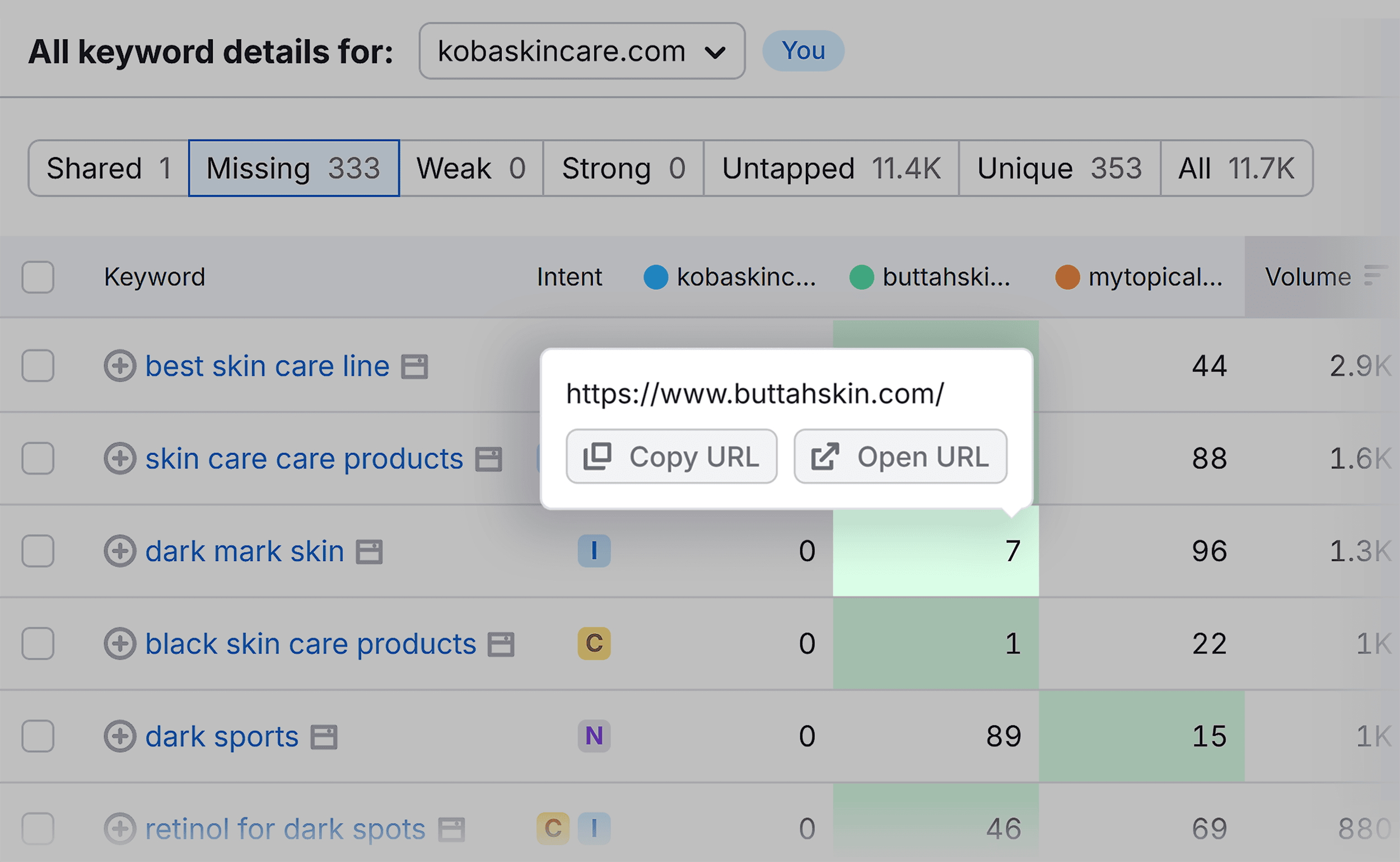
Further reading: Free Competitor Analysis Tool (Analyze SEO & PPC)
Step 5: Prioritize Keywords Based on Data
Now, you’re looking at this long list of target keywords and wondering, “Where do I even start?”
If your first instinct is to go for high-volume queries, pause and hit reset.
A keyword with 10,000 monthly searches might look tempting. But it’s probably difficult to rank for.
For example, we have two queries:
- “Wireless headphones” with 50,000 monthly searches
- “Best noise canceling headphones for airplanes” with 1,200 monthly searches
The second keyword is much more attainable since it targets a specific need.
That’s why our planner has space to note the search volume and ranking difficulty for each phrase and choose the right terms.
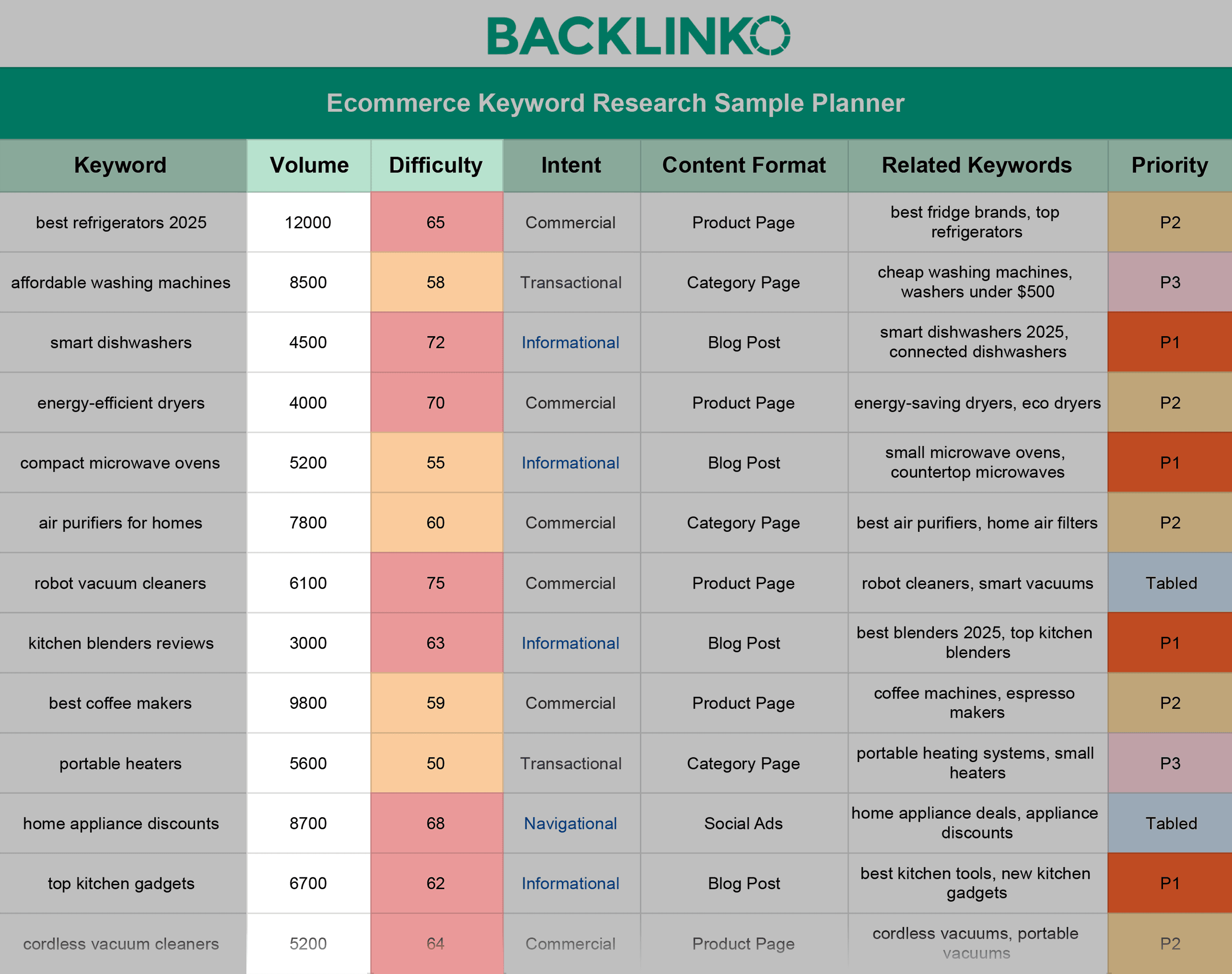
You can use Semrush to prioritize the right keywords.
Go to the Keyword Overview tool and add your seed keyword. I added “exercise bike for home gym” and hit “Search.”
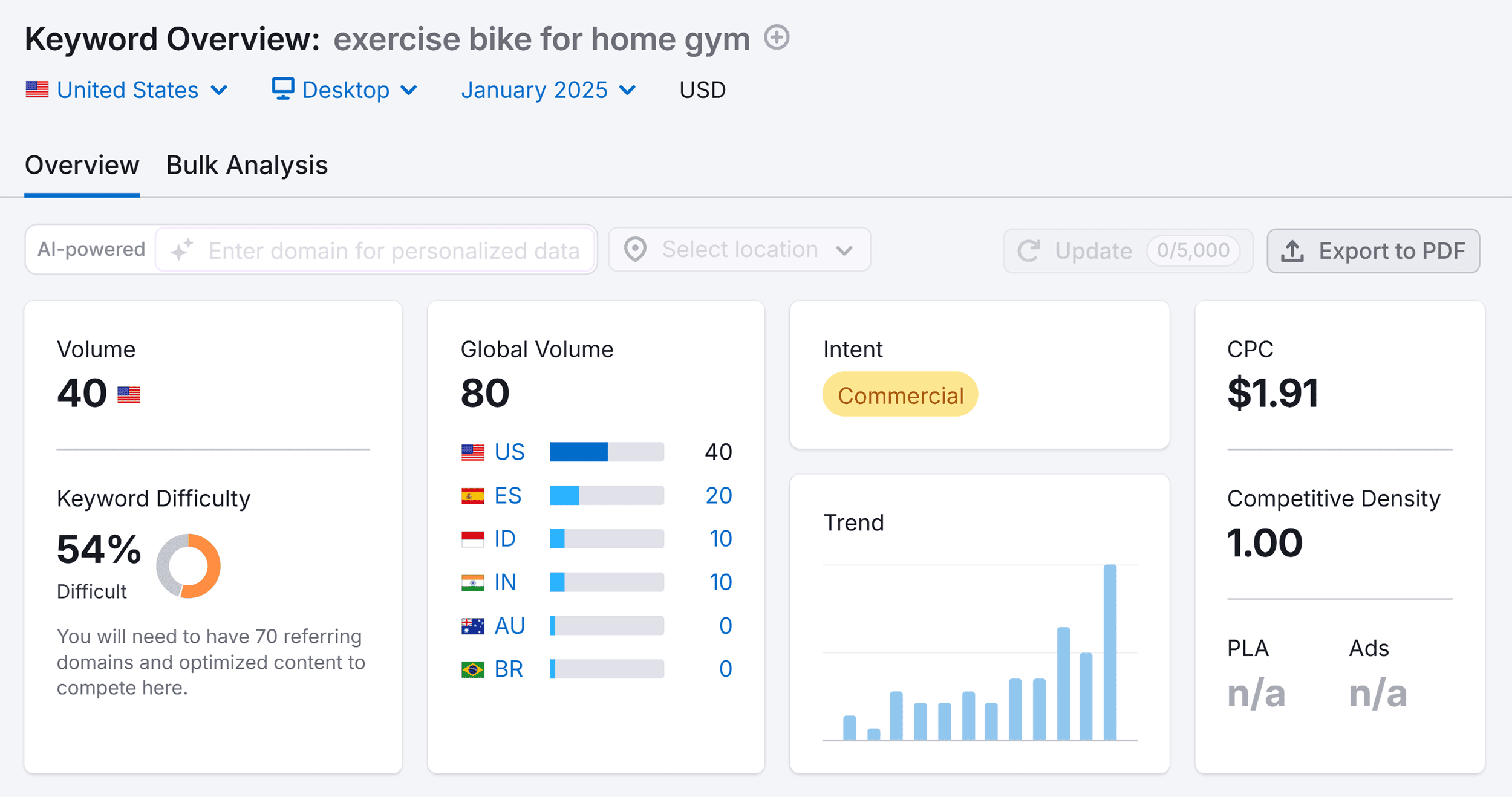
Keyword Overview’s comprehensive analysis tells me that this keyword:
- Has a low search volume in the United States and globally
- Is fairly competitive with a commercial search intent
- Has a low cost-per-click (CPC) value, which indicates the average price advertisers pay for this keyword
So, searchers use this keyword to explore different brands and products.
Pro tip: Look for keywords with a high CPC, which signals a strong commercial intent. If advertisers are willing to pay top dollar for a keyword, it probably converts well.
Keyword Overview also gives me a handy list of pages ranking in the search results.
I can analyze metrics like backlinks, traffic, and more to see what I’m competing against.
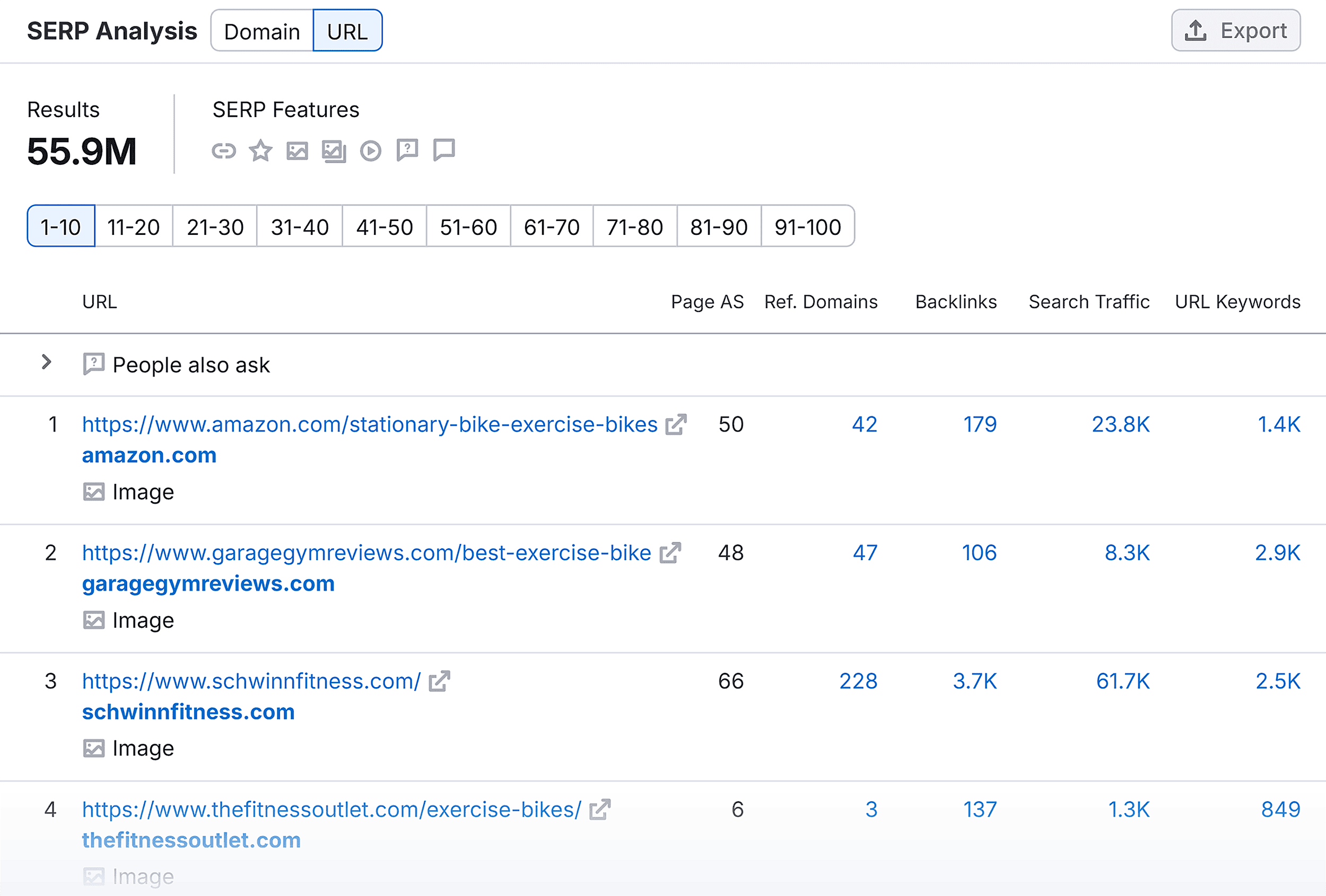
Once you’ve captured this data, go to Keyword Magic Tool to expand your list of target keywords.
Filter related terms by volume, difficulty, intent, and other metrics to shortlist the most relevant terms.
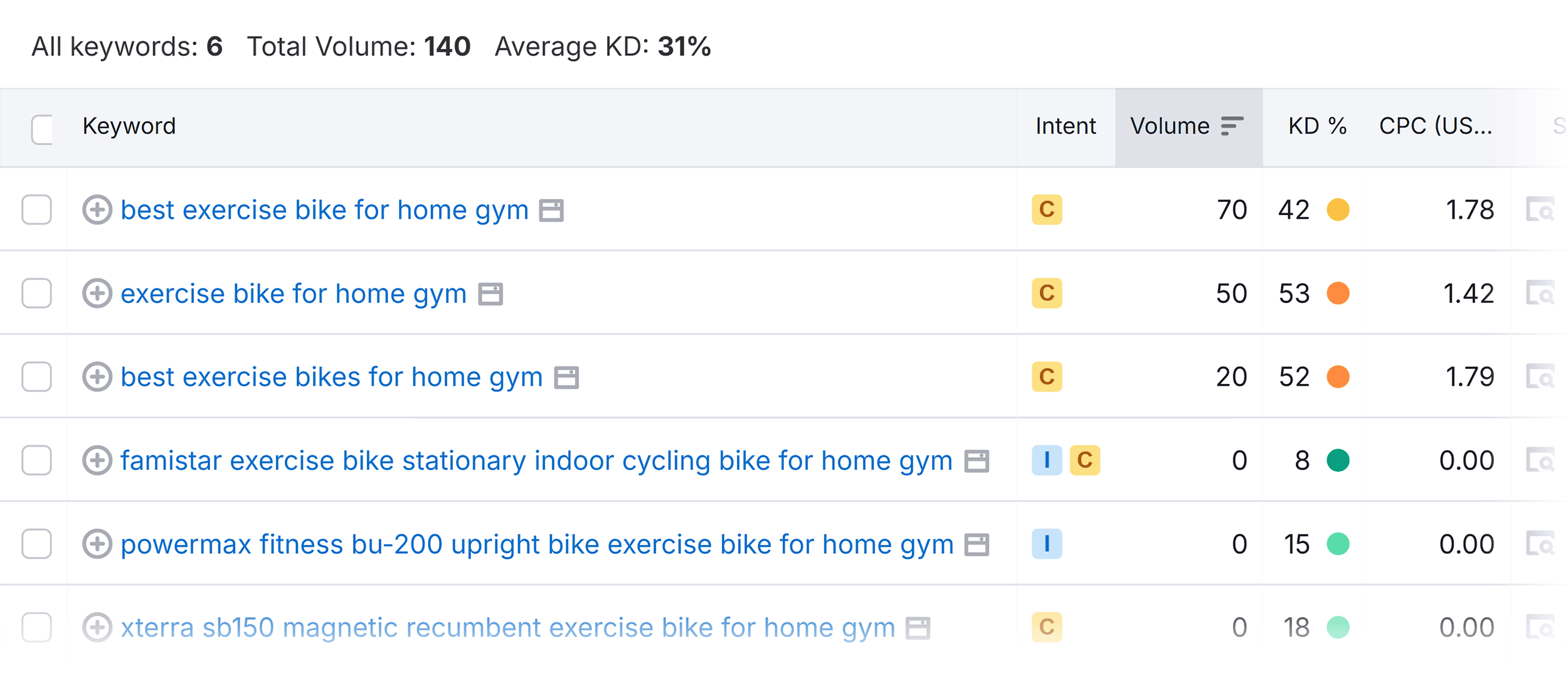
When you have a set of shortlisted keywords, do an effort-impact analysis.
For each keyword, assess the effort required to create content and rank well. Then, determine its overall impact on your marketing strategy.
This analysis will clarify the order of priority:
- Low Effort, High Impact: Your quick wins
- High Effort, High Impact: Long-term investments
- Low Effort, Low Impact: Fill-in opportunities
- High Effort, Low Impact: Avoid these
Let’s see this in action with the example of a fitness equipment retailer.
| High Effort | Low Effort | |
|---|---|---|
| High Impact | best home gym equipment
|
workout bench reviews
|
commercial gym equipment
|
home gym setup ideas
|
|
| Low Impact | vintage exercise equipment
|
gym equipment maintenance tips
|
olympic weightlifting equipment
|
how to clean resistance bands
|
As a result, the retailer should prioritize phrases like “workout bench reviews” and “home gym setup ideas” to get quick wins.
The brand should also invest effort into terms like “best home gym equipment” and “commercial gym equipment.”
Step 6: Build a Keyword-Focused Content Strategy
In the final step, you’re all set to build a content strategy around your keywords.
Each keyword serves a specific purpose — to educate, convince, or convert buyers.
When building your content strategy, match keywords to a specific phase of the buying process.
Then, align each keyword cluster with the right content format, like:
- Blog posts for information searches
- Product pages for transactional intent
- Videos or landing pages for commercial terms
Use the “Content Format” column in the planner.
This lets you organize keywords well for each term in your strategy.
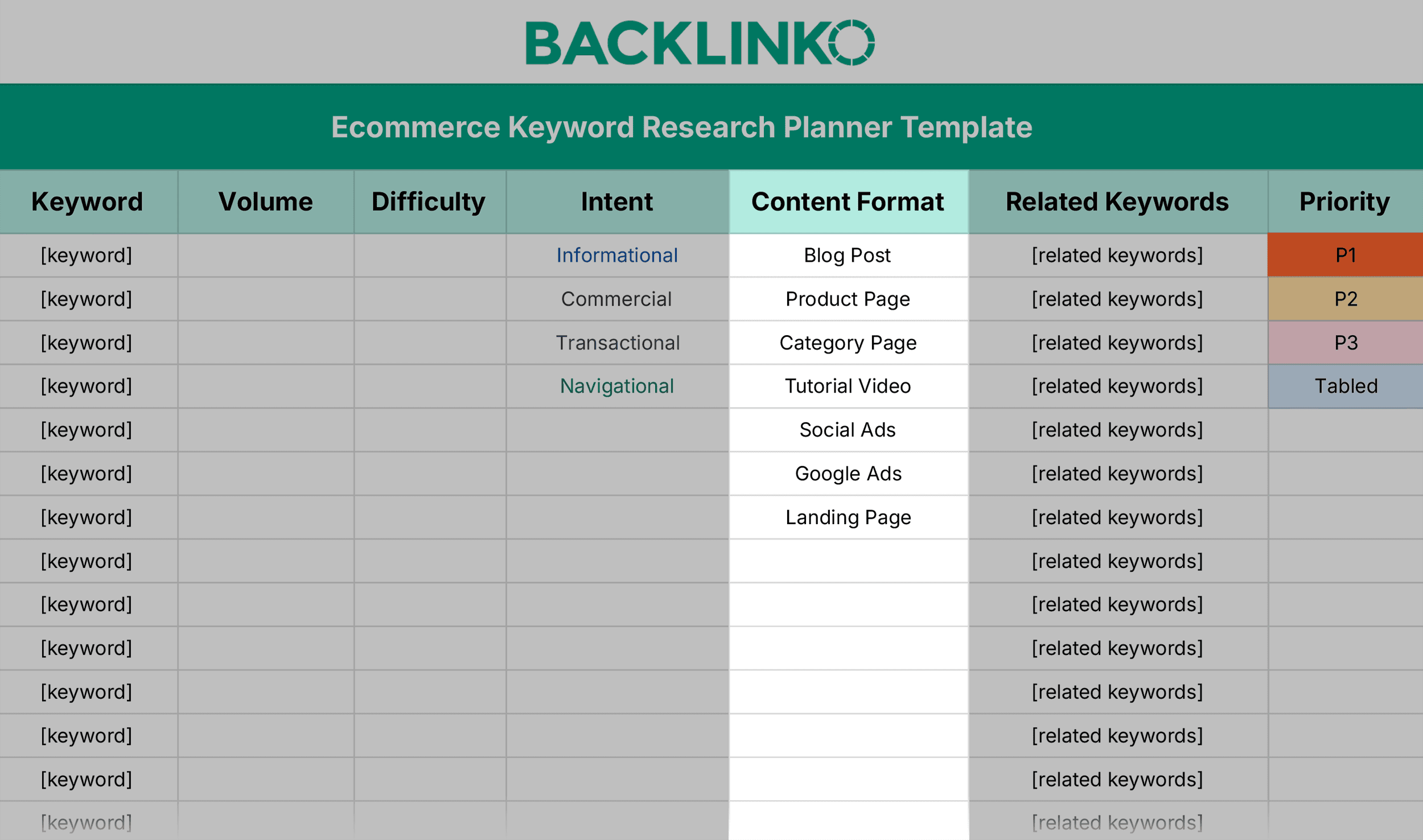
Finally, consolidate your strategy for various keyword opportunities in a content calendar. Focus on quick wins, seasonal trends, and more.
Let’s see how this would work for a dog food and clothing brand.
| Buyer Journey Stage | Keyword | Goal | Content Format |
|---|---|---|---|
| Awareness | “best dog food for puppies” | Educate buyers on options | Blog post, guide |
| “how to measure a dog for a coat” | Educate buyers on sizing | Blog post with visuals or infographic | |
| Consideration | “wet dog food pros and cons” | Help buyers compare options | Blog post, comparison video |
| “best dog raincoats” | Help buyers decide | Video or blog comparing products | |
| Decision/Conversion | “buy organic dog food online” | Drive conversions | Product landing page |
| “dog jacket sale” | Drive conversions | Promotional landing page or email |
2 Common Mistakes to Avoid in Ecommerce Keyword Research
Even with good keyword research, you can still make costly mistakes.
Your SEO growth can fall flat if you’re stuffing keywords, targeting very broad terms, ignoring search intent, or overlooking long-tail queries.
Watch out for these bigger missteps that can hurt your SEO and sales performance.
Poor Keyword Mapping
Many ecommerce sites target similar keywords across multiple pages, leading to keyword cannibalization.
This internal competition prevents search engines from ranking any page.
Plus, it confuses shoppers by showing them irrelevant pages from your site.
Prevent this by mapping these terms to varying search intent and your product hierarchy.
For instance, a camping equipment retailer can follow this map:
- “Camping tents” is mapped to a category page with a commercial intent
- “Foldable 8-person cabin tent” is mapped to a product page with a transactional intent
- “How to choose the right camping tent” is mapped to a blog page with an informational intent
Here’s what correct and incorrect keyword mapping looks like:
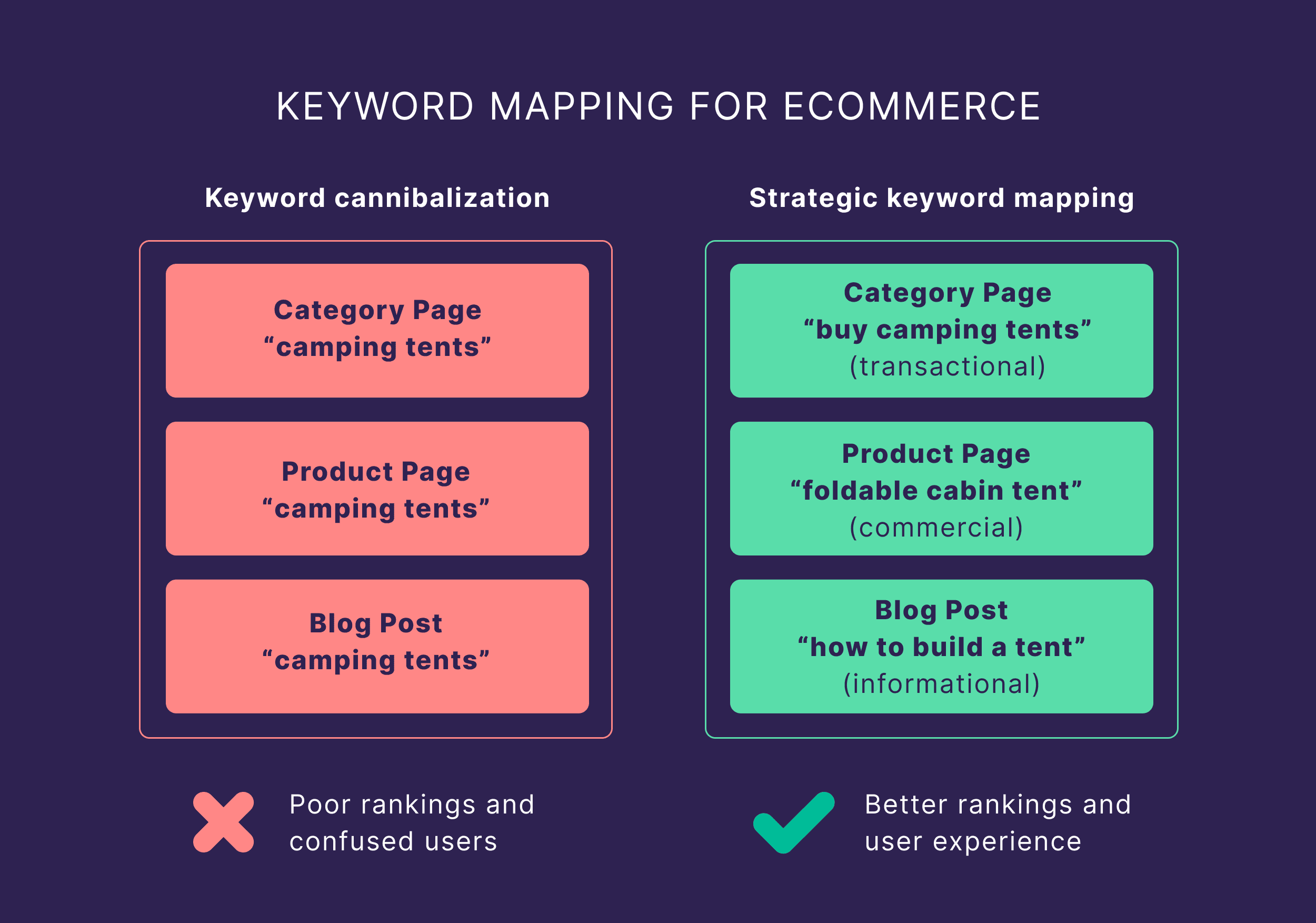
Each page on your website serves a different purpose in the conversion funnel. Keyword mapping reflects this hierarchy.
Prepare better: Use our free Keyword Mapping Template to prevent any costly mistakes.
Focusing Solely on One Keyword Type
Many ecommerce brands make the rookie mistake of using only transactional keywords.
Sure, “buy board games for children under 10” sounds like a great keyword.
But you’re leaving money on the table if you don’t target other search terms across the buyer journey.
Optimize your website to take buyers from discovery to purchase.
This would include:
- Informational queries like “what are the top strategy board games”
- Commercial phrases like “best cooperative games”
Turn Ecommerce Keyword Research into Long-Term Growth
Keyword research helps you understand exactly what buyers want and meet them where they are.
The result?
More qualified traffic, easier conversions, and, ultimately, higher revenue for your ecommerce store.
Use our free Keyword Research Planner Template to follow this guide effortlessly and create a strong strategy.
And when you’re ready to level up your SEO strategy, check out our in-depth guide on ecommerce SEO to make your store search-ready.
Backlinko is owned by Semrush. We’re still obsessed with bringing you world-class SEO insights, backed by hands-on experience. Unless otherwise noted, this content was written by either an employee or paid contractor of Semrush Inc.



